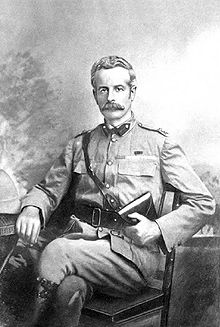|
Douglas Cochrane, 12th Earl of Dundonald
Lieutenant General Douglas Mackinnon Baillie Hamilton Cochrane, 12th Earl of Dundonald, KCB, KCVO (29 October 1852 – 12 April 1935), styled Lord Cochrane between 1860 and 1885, was a Scottish representative peer from 1886-1922[1][2] and a British Army general. Early lifeCochrane was the second but eldest surviving son of Thomas Cochrane, 11th Earl of Dundonald, by Louisa Harriet Mackinnon, daughter of William Alexander Mackinnon. Thomas Cochrane, 1st Baron Cochrane of Cults, was his younger brother. He was educated at Eton College.[3] Military career
Inverness Courier - Friday 30 November 1906[4]
Cochrane was commissioned into the Life Guards in July 1870,[5] and was promoted to lieutenant the following year and captain in 1878.[6] In 1884, he went to the Soudan in command of a detachment of the Camel Corps in the expedition for the relief of Khartoum, for his distinguished services in this campaign, he was mentioned in dispatched and received the medal with two clasps and the Khedive's bronze star with the brevet of lieutenant-colonel.[7] He then served in the Nile Expedition,[5] the Desert March and the Relief of Khartoum in 1885. In 1889 he reached the rank of full colonel in the army. In 1895, he was appointed Commanding Officer of the 2nd Life Guards.[5] He served in the Second Boer War and in November 1899 he volunteered to be the Commander of the Mounted Brigade, part of the South Natal Field Force, whilst there on the 22nd of the same month, Sir Redvers Buller gave him command over the mounted troops (which mainly consisted of colonial irregulars). For these services, he was mentioned six times in dispatches, received the medal with six clasps and was promoted to the rank of major-general for distinguished service to the field.[5] He took part in the Relief of Ladysmith in February 1900,[5] although his South African troops, unimpressed by his leadership, referred to him as "Dundoodle".[8] In April 1902, it was announced that Lord Dundonald would be appointed General Officer Commanding the Militia of Canada,[6] the senior military officer in Canada. He left Liverpool on 15 July,[9] and arrived in Quebec and Ottawa later the same month to take up his position.[10] He and his family stayed at Crichton Lodge in Rockcliffe, Ottawa, Ian McAllister of Morton College, Oxford was appointed as his private secretary whilst in charge.[11] During his time at Canada, he authored a scheme for the reorganisation of the Canadian militia on entirely new lines, which was adopted, he also wrote a drill & training book, directed towards Cavalry & infantry, additionally, he revamped the cadet corps structure and established several other associations aimed at enhancing the militia. He was also able to change the dress codes of many Scottish regiments to align more with their culture.[12] He served in Canada for two years until he was dismissed by the dominion cabinet due to his outburst at a dinner in Montreal, described as "utterances at a banquet" in newspaper articles and officially termed "Indiscretion and insubordination" by the cabinet.[13][14] In defence of his critics, Dundonald asserted that communication between him and the minister of the militia had been corrupted which left Canada defenceless.[15]
The Boston Record - 20 June 1904[16]
In 1910, Douglas was appointed the first 'gold stick in waiting' for king George V, and on arrival of Theodore Roosevelt, he was the king's 'aide de camp'.[17][18] He later served in the First World War as Chairman of the Admiralty Committee on Smoke Screens in 1915.[5]  In 1921, he became a 'special ambassador' to the Peruvian Centenary.[19] InventionsA list of his inventions that were patented; - 'Pocket-stove', (Patented 25 August 1896)[20] - 'Carriage and Traction Arrangement for a Machine or Quick Firing Gun', (Patented 18 August 1896)[21] - 'An Improvement in Nosebags for Horses', (Patented 7 September 1896)[22] - 'Improvements in Horse Traction Arrangements for Vehicles', (Patented 1 May 1897)[23] - 'Improvements in Ambulances and other Vehicles, especially adapted for Camel Traction', (patented 3 September 1897)[24] - 'Ammunition holder for machine guns', (Patented 19 July, I898)[25] - 'Bicycle saddle'; A Yielding Seat applicable in lieu of Saddle, (Patented 6 September, I898)[26] - 'Apparatus for Mechanical Patrontilførlsen by Guardian'; cartridge supply, (Patented 2 February 1899)[27] - 'Improvements in the Coupling and Traction of Bicycles', (Patented 18 February 1899)[28] - 'Tea or Coffee pot'; which was later manufactured as a teapot by the Wedgwood company, and marketed as the "SYP" (Simple Yet Perfect).[29] Later, in 1911 a licence to manufacture 'S.Y.P. teapots and coffee pots' was applied for with James Dixon & Sons.[30] (Patented 16 July 1901)[31][32] Personal life
Munsey's Magazine: Vol 32 Iss 1 - October 1904[33]
Lord Dundonald married Winifred Bamford-Hesketh, daughter of Robert Bamford-Hesketh, in 1878. For many years, the family lived at Gwrych Castle in North Wales, the seat of the Bamford-Hesketh family. The Countess of Dundonald did not accompany her husband to Canada. They had two sons and three daughters:[34]
Douglas owned several treasures from the Napoleonic wars, heirlooms from his grandfather, Thomas Cochrane, the 10th Earl, one of these items was a lock of Napoleon's hair.[35] His wife died in January 1924. Lord Dundonald died at his home in Wimbledon in April 1935, aged 82, and was succeeded in the earldom by his eldest son, Thomas. In 1926, he published an autobiographical book of his military career titled called 'My Army Life'.[36] He is buried in Achnaba Churchyard, Ardchattan near Benderloch, Lorne, Argyll & Bute. As his eldest son died unmarried and without issue, he was succeeded by his nephew, Ian Douglas Leonard Cochrane as the 14th Earl of Dundonald.[34] Honours and legacyLord Dundonald was appointed a Commander of the Royal Victorian Order (CVO) in December 1901,[37] and in June 1907 knighted as a Knight Commander (KCVO) of the order. Dundonald Park, in Centretown, Ottawa, is named after him. See alsoReferences
SourcesWikimedia Commons has media related to Douglas Cochrane, 12th Earl of Dundonald.
|
||||||||||||||||||||||||||||||||||||||
